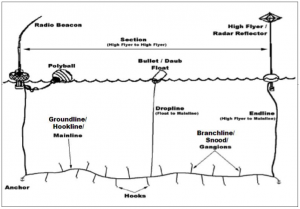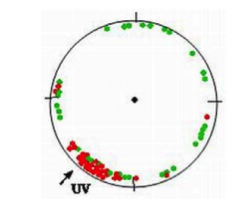by Megan Piechowski, RJD Intern
There is widespread knowledge and documentation of the problems shark species face in commercial fishing industries such as shark finning and longlining. Longlining is a fishing practice that uses a main line that is dozens of miles long with thousands of hooks deployed along the line. Along with the plights of these sharks lies many other affected marine species. For instance, along with the targeted pelagic fish, many marine birds and sea turtles are equally attracted to the baited hooks of longlines. This has caused a large estimated drop in the populations of seabirds and sea turtles, as the majority of this by-catch and fatalities goes undocumented. Groups of researchers have studied visual capabilities of sea turtles to understand whether different equipment designs can result in a decrease in unnecessary deaths that this fishing method produces. Many seabirds find their prey, small baitfish, in the ocean’s surface waters by diving headfirst towards their target. This hunting method has made many species especially vulnerable to longlining fishing methods.

This image represents the different parts and placements of the parts of a longline setup (Dietrich, Cornish, Rivera, Conant).
The albatross family of marine birds is especially susceptible to the decline in population size as they drown once hooked to the line. Due to the low number of natural predators to these birds, they have evolved to produce very few young throughout their lives. This is problematic when an estimated 7000 albatrosses (within two species of albatross) were killed in a single year in the 90’s (Stevens). It is in the best interest of both the fishing industry and the conservational biologists to limit the by-catch on these lines. The fishermen would have an increased catch of their targeted fish if more hooks were available without a sea turtle or marine bird attached. Likewise, conservational biologists are interested in protecting their specific species through technological improvements and fishing method modifications.
Scientists Fritsches and Warrant focused on the biological differences found between sea turtles species and pelagic fish species to determine if fishing gear could be modified to deter sea turtles. Due to hatchling sea turtle’s abilities to follow a light source, several experiments were conducted to determine the capabilities of the vision of these turtles. It was determined that tuna and billfish eye lenses block ultraviolet light, while green turtles’ eye lenses transmitted this wavelength of light (Fritsches, Warrant).

This graph supports the idea that hatchling sea turtles are able to sea UV light. The red dots represent the sea turtle’s orientation with the UV light, while the green dots represent their orientation without the UV light (Fritsches, Warrant).
Another measure of sea turtle vision used was the flicker fusion frequency, which measures an animal’s speed of vision. They found that marine animals that live mainly in the well lit surface waters (mahi mahi or green turtles) have “retinas that are capable of responding to light flickering with a frequency of 60 Hz” (Fritsches, Warrant). In contrast, animals that frequently dive to great depths (swordfish and leatherback sea turtles) “do not perceive the light as flashing because their retina is not capable of resolving such fast motion” (Fritsches, Warrant). This information suggests that different types of fishing lures attract different animals. Surface turtles, like the green turtle, are highly responsive to flashing light whereas diving sea turtles, like the leatherback, would be much less responsive to this input. The difference in diving behavior could provide a large consequence in vision between species of sea turtles (Crognale, Eckert, Levenson).
Before utilizing conservational management of fishing industries, an estimated 1,500 sea turtles were caught as by-catch per year (Dietrich, Cornish, Rivera, Conant). These researchers have compiled information that suggests that through implementing marine conservation techniques into management plans that the amount of sea turtles caught as by-catch has decreased by nearly 100 turtles a year (Dietrich, Cornish, Rivera, Conant). Seabirds are much more difficult to monitor as there are no official catch values reported by fisheries. The estimated yearly by-catch amount ranges widely from 100,000 to at least 500,000. In addition to the lack of observation in these fishing industries is a lack of reporting from fishermen, as a seabird species type is needed for a proper global catch estimate (Dietrich, Cornish, Rivera, Conant).
While it is easy for those who are passionate about shark conservation to become lost in a singular issue, it is important to remember that many marine species are facing severe population declines from similarly unsustainable fishing practices. It is unlikely for longlining to be stopped internationally, but it is possible to call for a change in deployment methods or gear type to decrease the by-catch rate of endangered seabirds and sea turtles. The large overlap in diet between marine animals has created a system of highly efficient removal of targeted (and also declining) pelagic fish and severe removal rates of other endangered marine animals that unknowingly hunt baited hooks and are killed. The decline in these predatory species creates a damaging impact on the health of the ecosystem, which is critical to monitor.
REFERENCES
Crognale, Eckert, Levenson. December 2006. The Sensory Biology of Sea Turtles: What Can They See, and How This Helps to Avoid Fishing Gear? U.S. Dep. Commer., NOAA Technical Memorandum NMFS-PIFSC-7
Dietrich, Kimberly S., Victoria R. Cornish, Kim S. Rivera, and Therese A. Conant. Best Practices for the Collection of Longline Data to Facilitate Research and Analysis to Reduce Bycatch of Protected Species. Rep. N.p., n.d. Web. 23 Nov. 2012. <http://www.nmfs.noaa.gov/pr/pdfs/interactions/longline%5fbycatch.pdf>.
Fritsches, Warrant. December 2006. Differences in the Visual Capabilities of Sea Turtles and Water Fisehs – Implications for Bycatch Reduction. U.S. Dep. Commer., NOAA Technical Memorandum NMFS-PIFSC-7
Stevens, William K. “Long Line Fishing Seen as Damaging To Some Fish and to the Albatross.” The New York Times. The New York Times, 05 Nov. 1996. Web. 23 Nov. 2012. <http://www.nytimes.com/1996/11/05/science/long-line-fishing-seen-as-damaging-to-some-fish-and-to-the-albatross.html?pagewanted=all>.





